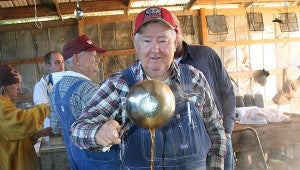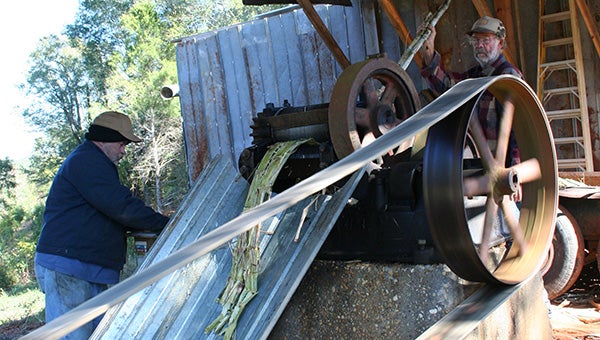Sweet Stuff: McCartha tells a few tall tales, keeps traditions alive during annual ‘syrup cooking’ in Ariton
Published 3:00 am Saturday, November 15, 2014

Perri McCartha mans the syrup pans during an all-day cooking two years ago.
MESSENGER PHOTO/JAINE TREADWELL
- McCartha grows the cane on his land. It is pressed on-site in the syrup shack before being cooked down into cane syrup. McCartha said 10 gallons of cane juice yields just one jar of syrup. MESSENGER PHOTO/JAINE TREADWELL
Never let the truth get in the way of a good story.
Whether Perri Sylvester McCartha is spinning a yarn or telling the gospel truth, no one is quite sure. Sometimes the thick, sweet vapors from the boiling syrup kettle hide the sly grin on his face. Other times, he chuckles at his own words. But either way, stories are as much a part of McCartha’s syrup cooking as the bees buzzing around the kettle.
“Medicine,” McCartha said and left the word hanging, then cracked a grin. “Men’s medicine. Men used to get sick a lot around syrup cooking time and the women folk would take the skimmin’s from the syrup and put them in a canner on the cook stove and put a pipe over the valve that releases the steam. They would attach a little ol’ piece of copper tubing and twist it through some water. The steam coming through would cool and condense and you’d have ‘medicine.’”
Those listening to McCartha’s tale would be taken in until he half mumbled to keep from laughing, “or it might be moonshine.”
Stories keep the syrup cookers entertained as well as those who come watch the two-hour process of taking cane juice, straight from the mill and cooking it to a thick, sweet syrup that would do any biscuit proud.
Although the McCartha brothers, Perri Sylvester and William Elijah, have been making syrup since they were no bigger than gallon jugs, they shy away from cooking syrup in an iron kettle over a wood fire.
“That’s the way our daddy cooked syrup back in the 1930s and the way we learned to cook it, but cooking syrup that way is asking for trouble,” Perri Sylvester McCartha said. “Our daddy knew how to keep a wood fire going at the right temperature to make good tasting syrup. But it’s mighty easy to scorch syrup cooking it that way and there’s no need to take a chance on it.”
The McCarthas broke tradition when they decided to cook syrup in a “pan.”
“We don’t cook syrup like most folks,” McCartha said. “The pan cooks the syrup off in a whole lot less time and, to me, the syrup is just better.”
McCartha grows about 13 varieties of sugar cane, that’s down from the 27 varieties he used to grow. Old Mother Nature has gotten where she wouldn’t cooperate.
“Used to be we’d get a shower of rain just about every late afternoon in the summer time,” McCartha said. “Then, we’d get some cool nights in the fall to bring the sweetness to cane. It’s not like that anymore. Most summers the rain’s held off and, this year, it’s been summertime weather way into the fall.”
McCartha put the mule in the pasture and runs the cane mill with John Deere power.
“Pulling a cane mill is hard work for a mule and you need rest to rest him,” he said. “A tractor keeps on going. We grind the cane right here at the syrup shack and people enjoy watching the cane mill and sampling the cane juice.”
A sample is just about all that is offered to visitors because it takes a lot of cane juice to make a gallon of syrup – to be exact, 10 gallons of juice to make one gallon of syrup.
McCartha said the pan method of making syrup works like a maze.
“The juice flows through what we call a warming pan and then through a pipe to the first pan or the top pan,” he said. “As the juice cooks, it works its way through the maze and when it gets to the end, it’s syrup.”
The process takes about two hours and the cooks are as busy as the bees all that time.
“We heat the pans with propane gas so we can regulate the heat but somebody has to constantly be skimmin’ the residue off the syrup. The residue we put in barrels for the hogs.”
A grin spread across McCartha’s face as he told how sometime the skimmin’s would be left in the barrel until they fermented.
“And, if the hogs got in those skimmin’s, they’d get drunk as dogs,” McCartha said leading into a story.
“One man found his hogs all laid out in the hog pen,” McCartha said. “He thought they were dead. They were Dead drunk.”
McCartha cooks his syrup to different degrees. At 220 degrees, the syrup is good for pancakes. Ten degrees more and it’s a thicker syrup for those who like it that way.
“But at 240 degrees, the syrup will tear up a biscuit,” McCartha said. “And, that’s my kind of syrup.”
The syrup will be bubbling and the bees will be buzzing today and next Saturday when McCartha hosts the annual Pee Wee Perri McCartha Syrup Cooking Festival at the syrup shack near Ariton.
For short, McCartha calls the event the POJ Festival for the variety of sugar cane being cooked.
“POJ stands for Pride of Jamaica but I call it Plain Ol’ Juice,” he said. “POJ was brought over here around 1920 so it’s been around along time and for good reason. It makes some of the best sugar cane syrup you can get – the old fashioned kind – like your granddaddy used to make back when syrup was a staple and everybody had syrup in the cellar.”
McCartha said everyone is invited to the POJ Festival whether they like sugar cane syrup or not.
“We’ve got the best sugar cane syrup anywhere around, and folks enjoy seeing it being made,” he said. “Oh, we like to sell it, but we like for folks to come and see how syrup is made the old-fashioned way just as much as selling it. Syrup making is a dying art. Sometimes, you can see syrup-making demonstrations at festivals but there aren’t many places like the syrup shack. It’s the real thing, so y’all come.”




